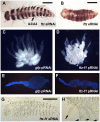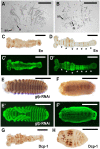Conservation and variation in pair-rule gene expression and function in the intermediate-germ beetle Dermestes maculatus
- PMID: 29084804
- PMCID: PMC5769621
- DOI: 10.1242/dev.154039
Conservation and variation in pair-rule gene expression and function in the intermediate-germ beetle Dermestes maculatus
Abstract
A set of pair-rule (PR) segmentation genes (PRGs) promotes the formation of alternate body segments in Drosophila melanogaster Whereas Drosophila embryos are long-germ, with segments specified more or less simultaneously, most insects add segments sequentially as the germband elongates. The hide beetle Dermestes maculatus represents an intermediate between short- and long-germ development, ideal for comparative study of PRGs. We show that eight of nine Drosophila PRG orthologs are expressed in stripes in Dermestes Functional results parse these genes into three groups: Dmac-eve, -odd and -run play roles in both germband elongation and PR patterning; Dmac-slp and -prd function exclusively as complementary, classic PRGs, supporting functional decoupling of elongation and segment formation; and orthologs of ftz, ftz-f1, h and opa show more variable function in Dermestes and other species. While extensive cell death generally prefigured Dermestes PRG RNAi-mediated cuticle defects, an organized region with high mitotic activity near the margin of the segment addition zone is likely to have contributed to truncation of eveRNAi embryos. Our results suggest general conservation of clock-like regulation of PR stripe addition in sequentially segmenting species while highlighting regulatory rewiring involving a subset of PRG orthologs.
Keywords: Beetle; Dermestes; Evo-devo; Germband elongation; Pair-rule gene; Segmentation.
© 2017. Published by The Company of Biologists Ltd.
Conflict of interest statement
Competing interestsThe authors declare no competing or financial interests.
Figures







Similar articles
-
Dermestes maculatus: an intermediate-germ beetle model system for evo-devo.Evodevo. 2015 Oct 16;6:32. doi: 10.1186/s13227-015-0028-0. eCollection 2015. Evodevo. 2015. PMID: 26478804 Free PMC article.
-
Shifting roles of Drosophila pair-rule gene orthologs: segmental expression and function in the milkweed bug Oncopeltus fasciatus.Development. 2019 Sep 10;146(17):dev181453. doi: 10.1242/dev.181453. Development. 2019. PMID: 31444220 Free PMC article.
-
A screen for genes that interact with the Drosophila pair-rule segmentation gene fushi tarazu.Genetics. 2004 Sep;168(1):161-80. doi: 10.1534/genetics.104.027250. Genetics. 2004. PMID: 15454535 Free PMC article.
-
Hox genes, evo-devo, and the case of the ftz gene.Chromosoma. 2016 Jun;125(3):535-51. doi: 10.1007/s00412-015-0553-6. Epub 2015 Nov 23. Chromosoma. 2016. PMID: 26596987 Free PMC article. Review.
-
Recent approaches lead to a deeper understanding of diverse segmentation mechanisms in insects, with a focus on the pair-rule genes.Curr Opin Insect Sci. 2025 Apr;68:101317. doi: 10.1016/j.cois.2024.101317. Epub 2024 Dec 3. Curr Opin Insect Sci. 2025. PMID: 39638284 Review.
Cited by
-
Anterior-posterior patterning of segments in Anopheles stephensi offers insights into the transition from sequential to simultaneous segmentation in holometabolous insects.J Exp Zool B Mol Dev Evol. 2023 Mar;340(2):116-130. doi: 10.1002/jez.b.23102. Epub 2021 Nov 3. J Exp Zool B Mol Dev Evol. 2023. PMID: 34734470 Free PMC article.
-
Hemimetabolous insects elucidate the origin of sexual development via alternative splicing.Elife. 2019 Sep 3;8:e47490. doi: 10.7554/eLife.47490. Elife. 2019. PMID: 31478483 Free PMC article.
-
Same rule, different genes: Blimp1 is a pair-rule gene in the milkweed bug Oncopeltus fasciatus.Sci Adv. 2024 Nov 15;10(46):eadq9045. doi: 10.1126/sciadv.adq9045. Epub 2024 Nov 15. Sci Adv. 2024. PMID: 39546609 Free PMC article.
-
Patterning with clocks and genetic cascades: Segmentation and regionalization of vertebrate versus insect body plans.PLoS Genet. 2021 Oct 14;17(10):e1009812. doi: 10.1371/journal.pgen.1009812. eCollection 2021 Oct. PLoS Genet. 2021. PMID: 34648490 Free PMC article. Review.
-
Spatiotemporal variation in cell proliferation patterns during arthropod axial elongation.Sci Rep. 2021 Jan 11;11(1):327. doi: 10.1038/s41598-020-79373-0. Sci Rep. 2021. PMID: 33431947 Free PMC article.
References
-
- Akam M. (1987). The molecular basis for metameric pattern in the Drosophila embryo. Development 101, 1-22. - PubMed
MeSH terms
Substances
Grants and funding
LinkOut - more resources
Full Text Sources
Other Literature Sources
Research Materials
Miscellaneous

